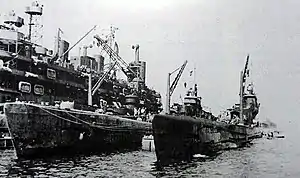Japanese submarine I-14
The Japanese submarine I-14 was a Type AM submarine built for the Imperial Japanese Navy (IJN) during World War II.
 I-14 (right) beside USS Proteus (far left) and I-401 (center left), on 29 August 1945. | |
| History | |
|---|---|
| Name: | I-14 |
| Laid down: | May 18, 1943 |
| Launched: | March 14, 1944 |
| Commissioned: | March 14, 1945 |
| In service: | 1945 |
| Fate: | Sunk as target off Hawaiian Islands, 28 May 1946 |
| General characteristics | |
| Class and type: | Type AM submarine |
| Displacement: |
|
| Length: | 113.7 m (373 ft 0 in) overall |
| Beam: | 11.7 m (38 ft 5 in) |
| Draft: | 5.9 m (19 ft 4 in) |
| Installed power: |
|
| Propulsion: |
|
| Speed: |
|
| Range: |
|
| Test depth: | 100 m (330 ft) |
| Crew: | 108 |
| Armament: |
|
| Aircraft carried: | 2 × Aichi M6A Seiran floatplane |
| Aviation facilities: | 1 × catapult |
Design and description
The Type AM submarines were versions of the preceding A2 class-class with the command facilities replaced by an enlarged aircraft hangar were fitted for a pair of Aichi M6A1 floatplane bombers.[1] They displaced 3,661 tonnes (3,603 long tons) surfaced and 4,838 tonnes (4,762 long tons) submerged. The submarines were 113.7 meters (373 ft 0 in) long, had a beam of 11.7 meters (38 ft 5 in) and a draft of 5.9 meters (19 ft 4 in). They had a diving depth of 100 meters (330 ft).[2]
For surface running, the boats were powered by two 2,200-brake-horsepower (1,641 kW) diesel engines, each driving one propeller shaft. When submerged each propeller was driven by a 300-horsepower (224 kW) electric motor. They could reach 16.75 knots (31.02 km/h; 19.28 mph) on the surface and 5.5 knots (10.2 km/h; 6.3 mph) underwater.[3] On the surface, the AMs had a range of 21,000 nautical miles (39,000 km; 24,000 mi) at 16 knots (30 km/h; 18 mph); submerged, they had a range of 60 nmi (110 km; 69 mi) at 3 knots (5.6 km/h; 3.5 mph).[4]
The boats were armed with six internal bow 53.3 cm (21.0 in) torpedo tubes and carried a total of a dozen torpedoes. They were also armed with a single 140 mm (5.5 in)/40 deck gun and two triple and one single mount for 25 mm (1 in) Type 96 anti-aircraft guns.[4]
The aircraft hangar was enlarged to accommodate two aircraft. It was offset to the right of, and was faired into the base of, the conning tower which protruded over the left side of the hull. A single catapult was positioned on the forward deck. Two folding crane on the forward deck were used to recover the floatplanes.[4]
Construction and career
I-14 surrendered at sea at the end of the war. It was one of five subs that were brought to Hawaii at war's end, then sunk off Oahu after U.S. technicians had studied their secrets.[5] It was located in 2009 by a group from the Hawaii Undersea Research Laboratory and National Oceanic and Atmospheric Administration.[6]
See also
Notes
- Layman & McLaughlin, p. 176
- Bagnasco, p. 189
- Chesneau, p. 200
- Carpenter & Dorr, p. 110
- LATimes, 2 Japanese subs sunk after World War II found
- New York Times, 2 Sunken Japanese Subs Are Found Off Hawaii
References
- Bagnasco, Erminio (1977). Submarines of World War Two. Annapolis, Maryland: Naval Institute Press. ISBN 0-87021-962-6.
- Boyd, Carl & Yoshida, Akikiko (2002). The Japanese Submarine Force and World War II. Annapolis, Maryland: Naval Institute Press. ISBN 1-55750-015-0.
- Carpenter, Dorr B. & Polmar, Norman (1986). Submarines of the Imperial Japanese Navy 1904–1945. London: Conway Maritime Press. ISBN 0-85177-396-6.
- Chesneau, Roger, ed. (1980). Conway's All the World's Fighting Ships 1922–1946. Greenwich, UK: Conway Maritime Press. ISBN 0-85177-146-7.
- Hashimoto, Mochitsura (1954). Sunk: The Story of the Japanese Submarine Fleet 1942 – 1945. Colegrave, E.H.M. (translator). London: Cassell and Company. ASIN B000QSM3L0.
- Layman, R.D. & McLaughlin, Stephen (1991). The Hybrid Warship:The Amalgamation of Big Guns and Aircraft. London: Conway Maritime Press. ISBN 0-85177-555-1.
- Stille, Mark (2007). Imperial Japanese Navy Submarines 1941-45. New Vanguard. 135. Botley, Oxford, UK: Osprey Publishing. ISBN 978-1-84603-090-1.